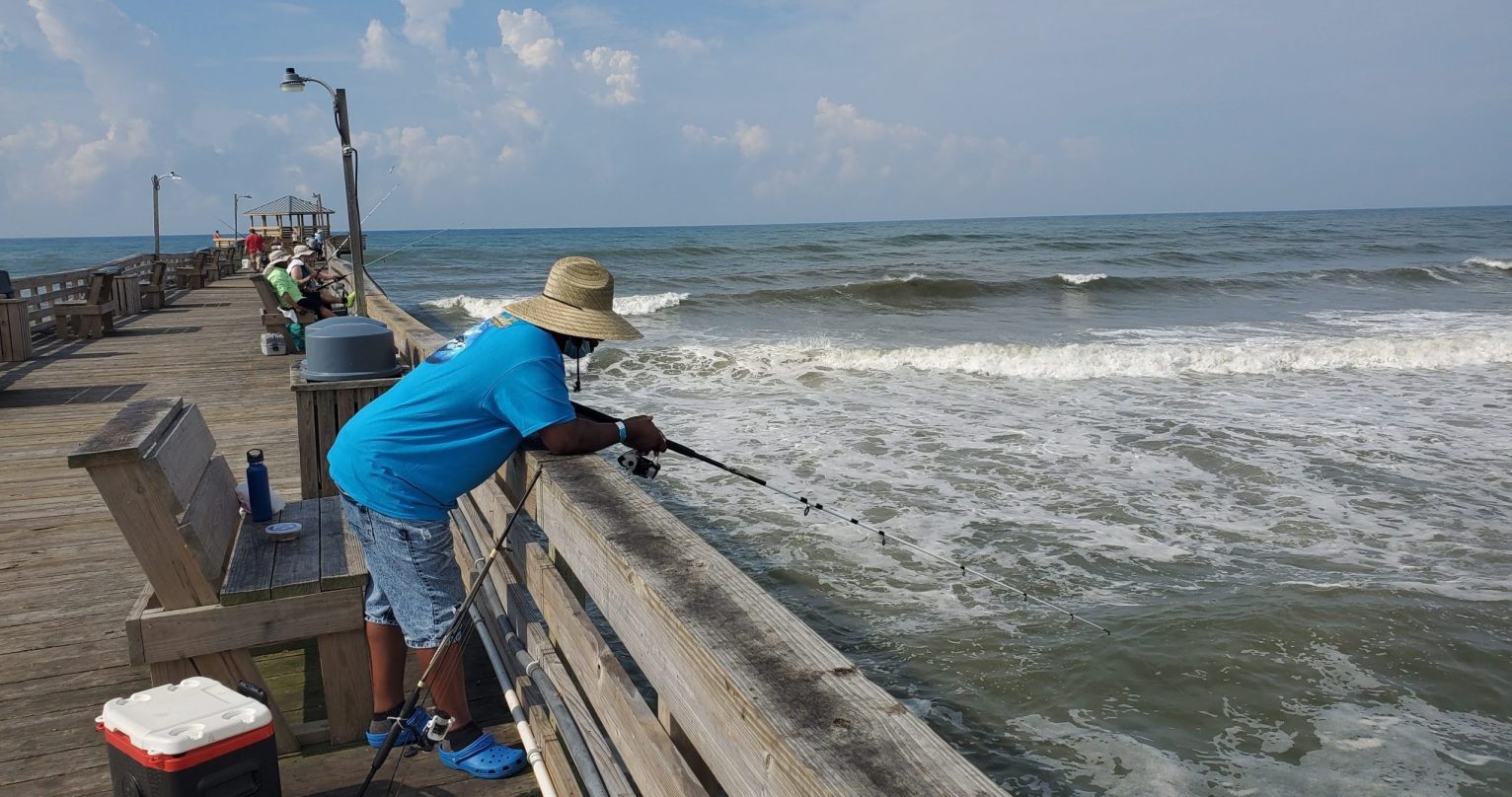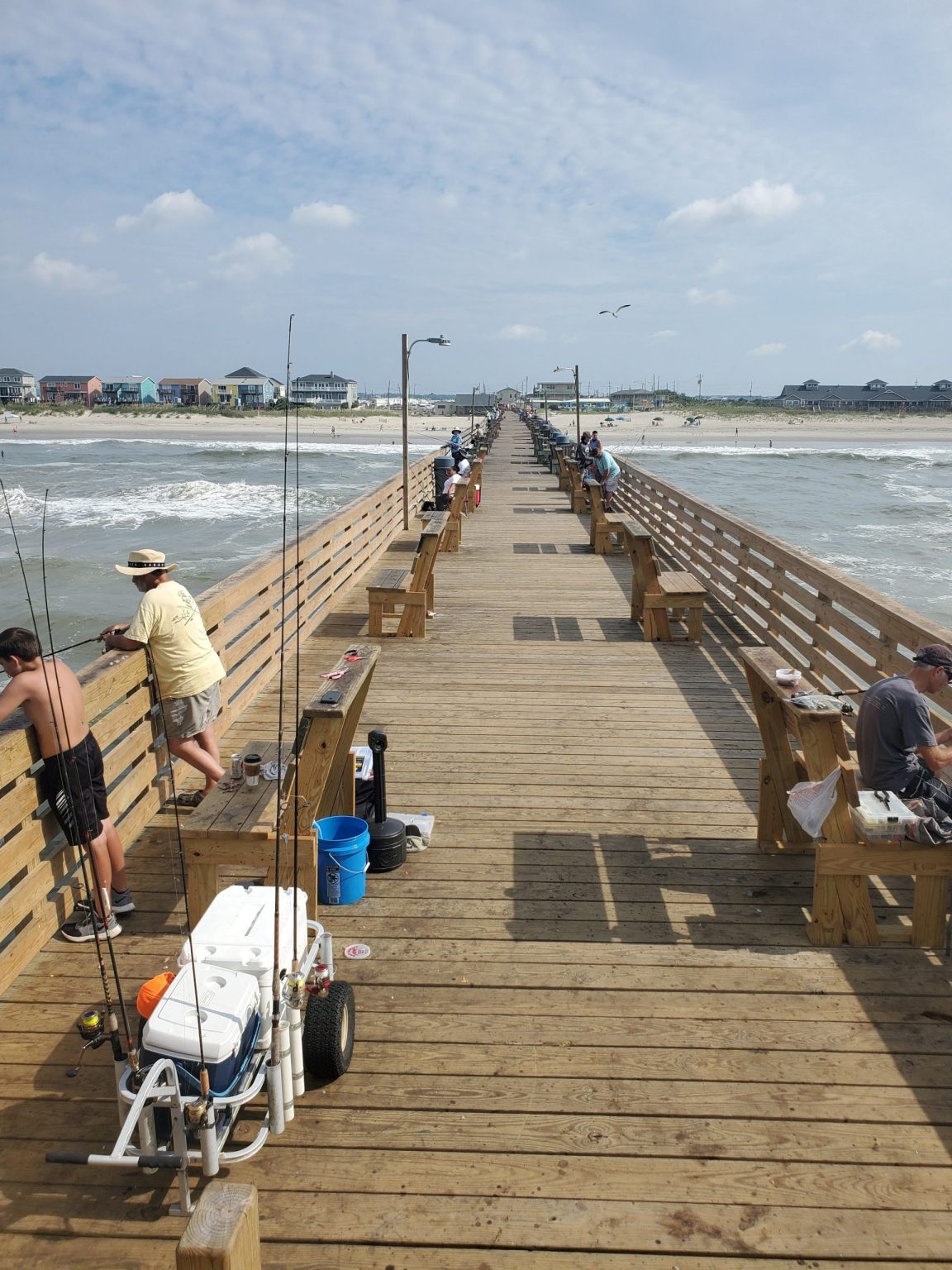
Reprinted from Carolina Public Press
The Oceanana Fishing Pier in Atlantic Beach lost 150 feet of boardwalk along with the Barnacle Bar in a record high tide and tidal surge during Hurricane Florence in 2018.
Supporter Spotlight
The storm crashed into land near Wrightsville Beach then tortured the central North Carolina coast with fierce winds, devastating rain and a record-breaking storm surge of 13 feet that submerged the Oceanana’s deck.
Florence could have been a terminal blow to the 60-year-old pier, which also sustained damage from Hurricane Irene in 2011.
But Trace Cooper and his family, the owners of the pier, decided to rebuild in spite of the potential for more frequent and punishing storms in the future due to climate change.
According to Cooper, who also serves as Atlantic Beach’s mayor, it wasn’t an easy decision. In fact, the fate of the Oceanana and other ocean piers in North Carolina may be in peril, threatened by climate change, ebbing demand and rising real estate values.
Cooper told CPP that the cost to repair the pier is roughly $1,000 per foot. The last rebuild in 2018 and 2019 was nearly $300,000. Since the price of insurance is prohibitive, the Coopers incurred the entire cost to restore the pier.
Supporter Spotlight
“If you do the math, if we go 15 to 20 years without a hurricane, it makes sense to rebuild,” he said. “We’ve lost the pier twice in a decade. That’s never happened before.”
In the 1990s, Bogue Banks, a 21-mile barrier island near Morehead City, once anchored seven ocean piers to its shore.
Today, there are just two on the island; the 1,000-foot-long Oceanana is one of them. Two piers in Atlantic Beach, the Sportsman’s Pier and the Triple S Pier, were razed in 2006 to make room for development.
The other remaining structure, the Bogue Inlet Fishing Pier in Emerald Isle, was placed on the market earlier this month. Its future is uncertain. The asking price is $18 million.
The heyday of seaside piers, Cooper said, was the 1950s and 1960s.
Cooper’s grandfather A.B. Cooper built the Oceanana Fishing Pier and a motel in 1959. The 8-acre property bounded by State Road 58 on one side and the Atlantic Ocean on the other also includes several dozen vacation trailers whose owners lease land from the Oceanana.
“For a long time, if you wanted to fish on the ocean, you had to go to a pier,” Cooper said. At the height of the pier boom, in 1980, there were 36 ocean piers along the state’s coast.

Now, according to Chris Wilson, who collects recreational fishing data for the North Carolina Division of Marine Fisheries, 20 coastal piers remain in operation.
Excluding the state-owned Jennette’s Pier in Nags Head on the Outer Banks and the town-operated Oak Island Pier south of Wilmington, all are private enterprises.
Cooper attended college in New York and worked as an attorney in Silicon Valley. But in 2011, he returned to Atlantic Beach to operate the family’s business. Since his return, aside from a recent spike in visitation, the number of pier anglers has diminished.
Cooper attributes the decline in the Oceanana’s fishing business to the relatively low cost of financing a boat. Longer loan terms and low borrowing rates have eased the purchase of oceangoing vessels and, perhaps, has made pier fishing less of an attraction.
In 2015, when the Oceanana began collecting data, 20,036 people paid $10 per day — it’s now $12 per day — to fish from the pier. Walking, visiting the bar or sightseeing from the pier has no fee.
In 2017, 17,171 people fished at the pier, a 14.3% decline from 2015. In 2019, only 11,369 paid to fish from the Oceanana, although storm damage and construction closures resulting from Florence, Cooper said, contributed to the decline.
Wilson with the division said that since the state agency began collecting data in 2012, North Carolina piers have averaged 340,000 users per year. Casting aside 2018 and 2019, which were impacted by Hurricane Florence, Wilson said use is trending upward slightly.
Still, Cooper isn’t hopeful that the Oceanana’s numbers will resurface, nor is he banking on it.
According to Cooper, 25% of the revenue comes from fishing passes, bait, tackle and rod-and-reel rental, but the majority of the revenue is generated by the motel and the restaurant in the pier house.
Piers that rely only on fishing may have more incentive to sell to a developer, especially if the price of scarce oceanfront property continues to rise.
“The pier is an amenity for the hotel and helps us rent rooms,” he said. “We have a reason to rebuild that a stand-alone pier doesn’t.”
Providing habitat for coastal species
A primary reason that anglers are drawn to piers is that the structure orchestrates a lush habitat of marine life. Barnacles and sea urchins form on the pylons and provide a smorgasbord that feeds a range of fishes, including northern puffers, sheepshead and Atlantic spadefish.
They also attract hunter species, such as southern flounders, which visit piers seeking prey.
Discarded carcasses, tossed by anglers, are a substantial food source for rays, crabs, sharks and birds. And the elevated boardwalk provides a better vantage than the shore for saltwater anglers who pursue Spanish mackerel and spotted sea trout.
According to Wilson, the biggest catches by weight from North Carolina’s ocean piers in 2019 were bluefish, Spanish mackerel, kingfish, pompano and pufferfish.
Anne Deaton, a division habitat manager, said the habitat that developed along barrier islands, such as Bogue Banks, has been transformed by humans and nature over time.
Geologically speaking, barrier islands are offshore deposits of sand separated from the mainland. The sand is perpetually shifted during floods, and the dunes roll toward the mainland during storms.
To protect property and counter shore erosion, beach nourishment projects have altered the marine landscape along the shore of the islands.
“We’re putting sand over the shallows near the shore,” Deaton said. The result is a rising sea floor below the pier, which means that species, such as spot and croaker, are now farther from the beach.
Many barrier islands also have muddy sloughs — deep, underwater troughs running parallel to the beach. Fish travel them looking for food, such as crabs or sand fleas.
“Old-timers have told me that there were muddy sloughs near the surf break that attracted shrimp” and other predators at Atlantic Beach, Deaton said.
But the bottom of nourished beaches can become hard from additions of mud, sand and shells. The near-shore sloughs are often covered, making it difficult for small flounder to burrow or mullet to feed. That loss of habitat, whether caused by storms or human-made projects, is a major fisheries management concern.

Piers as an economic asset
Saltwater fishing and marine habitat, however, aren’t the only assets piers offer.
Like lighthouses, they are public goods. That is, they are an economic good in which users can’t be excluded and also provide a community or civic benefit.
For example, the breaking waves near the Oceanana and other piers along the eastern coast are hallowed waters for surfers. By forming sand bars, piers enhance the waves that reliably peak on either side of the structure.
And while occasionally visitors may have one too many beers and tensions sometimes flare between surfers and anglers, Cooper said the Oceanana remains committed to his grandfather’s vision of building a family-friendly operation.
In the ’30s and ’40s, Atlantic Beach, Cooper said, was initially developed and funded, in large part, by Eastern North Carolina tobacco money. But after World War II, the eastern end of Bogue Banks attracted middle-class farmers from Kinston, Goldsboro, Wilson and Greenville.
By the 1980s, condominium complexes rose. In the 1990s and 2000s, single-home development filled in empty spaces. Now, Cooper said, 95% of land in Atlantic Beach is developed. Predictably, multimillion-dollar homes are replacing modest beach cottages.
“This town reflects the evolution of North Carolina,” Cooper said. “It’s more affluent in Eastern North Carolina than when it was primarily agricultural. What happens in Raleigh will happen here.”
Based on ZIP codes, Cooper said, Wake County residents are the largest group of homeowners in Atlantic Beach.
The grill fare in the Oceanana’s Pier House Restaurant also reflects the economic status of visitors to Atlantic Beach. On the menu, fresh, local seafood has supplanted hot dogs.
Yet the pier has remained more pluralistic, economically speaking, than perhaps the rest of Atlantic Beach. Much like public spaces and public parks, piers may be more inclusive and a shared place because of the low entrance barriers.
“Piers offer access to people from all walks of life, a wide range of income, different races and different levels of fishing ability,” said John Hadley, an economist with the South Atlantic Fisheries Management Council who authored an NCDMF social and economic study of piers in 2012.
“Many are also handicapped-accessible. They are pillars of the beach community. North Carolina is pretty unique in the number of ocean piers. They are one of the defining features of the North Carolina coast.”
Wilson added that piers are a microcosm of fishing society.
“You’ve got your tourists and cliques of regulars – the pier rats that you see over and over again. It’s a microcosm of fishing society. When one pier disappears, it’s a loss.”
Indeed, a characteristic of a public good is that private parties may struggle to profit, which undermines their incentive to provide them.
While some have suggested that the state should build additional public piers, such as Jennette’s Pier, not everyone is on board with that idea.
“You want to maintain the public benefit and access, but at the same time, not inadvertently put other piers out of business that have been operating for decades,” said Hadley.
Unexpectedly, Cooper said, after fishing resumed during phase 1 of the state’s reopening from the coronavirus pandemic this spring, the Oceanana experienced a spike in the number of anglers.
“The pier was a godsend during March and April and kept our people working,” Cooper said. “It’s the first time we leaned on the fishing business in a while.”

Despite the economic slowdown caused by the pandemic, Cooper said he is preparing plans to redevelop the property.
The outdated motel and pier house will be replaced, and owners of trailers who lease land are on notice that redevelopment is imminent. That portion of the property will be replaced by vacation rentals.
While the buildings and space will get a fresh look, Cooper said the pier will remain.
That is, as long as Mother Nature allows.
“If a hurricane happens again this year, it wouldn’t make sense economically to rebuild the pier,” he said.
“It’s all private money. We want to continue to have public access, but there’s no state or federal money to help us. There is a reason there aren’t a lot of piers left: They don’t make great businesses.”
Coastal Review Online is partnering with Carolina Public Press to provide readers with more environmental and lifestyle stories of interest about our coast.







